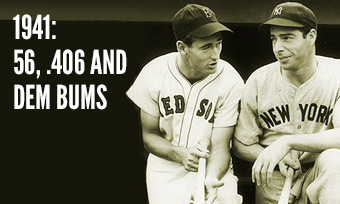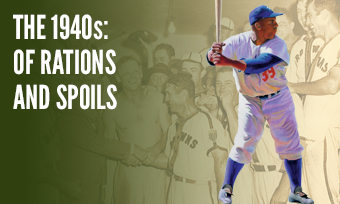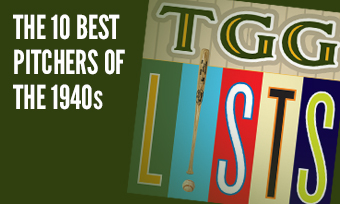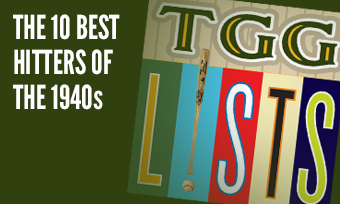The Yearly Reader
Leaders and Honors, 1941
Our list of baseball’s top 10 hitters and pitchers in both the American League and National League for the 1941 baseball season, as well as the awards and honors given to the game’s top achievers of the year.
The National League’s Top 10 Hitters, 1941
Bold type in brick red indicates league leader.
1. Pete Reiser, Brooklyn
Key Numbers: 137 games, .343 average, 117 runs, 184 hits, 39 doubles, 17 triples, 14 home runs, 76 RBIs, 11 hit-by-pitches, .558 slugging percentage.
The reckless Reiser finished the season physically intact—in stark contrast to coming years—and showed how dominant he could be in good health.
2. Dolph Camilli, Brooklyn
Key Numbers: .285 average, 92 runs, 29 doubles, 6 triples, 34 home runs, 120 RBIs, 104 walks, 115 strikeouts.
Despite the damage done to opponents by the tornado-like Reiser, Camilli still copped the NL MVP award, and by a rather wide (300-183) margin. The power of power.
3. Johnny Mize, St. Louis
Key Numbers: 126 games, .317 average, 39 doubles, 8 triples, 16 home runs, 100 RBIs, 70 walks, 16 intentional walks.
After clubbing 43 homers the year before, Mize had only four through the end of June before turning it up late in his last season at St. Louis.
4. Mel Ott, New York
Key Numbers: .286 average, 89 runs, 29 doubles, 27 home runs, 90 RBIs, 100 walks.
For the third straight year, Ott walked exactly 100 times.
5. Elbie Fletcher, Pittsburgh
Key Numbers: .288 average, 95 runs, 29 doubles, 13 triples, 11 home runs, 74 RBIs, 118 walks, .421 on-base percentage.
With the Waners on the wane and/or gone in Pittsburgh, Fletcher took over as the Bucs’ most reliable hitter, leading the NL in walks and OBP for the second straight year.
6. Joe Medwick, Brooklyn
Key Numbers: 133 games, .318 average, 100 runs, 171 hits, 33 doubles, 10 triples, 18 home runs, 88 RBIs.
In his first full year with the Dodgers, Medwick thought he made fans for life at Brooklyn by hitting .405 against the Giants in 84 at-bats—but two years later, he’d been playing for those same archrivals.
7. Stan Hack, Chicago
Key Numbers: .317 average, 694 plate appearances, 111 runs, 186 hits, 33 doubles, 5 triples, 99 walks, 10 stolen bases.
The veteran third baseman hit .317 for the second straight year and finished a streak of six consecutive seasons scoring at least 100 runs, tying a NL record at the time.
8. Enos Slaughter, St. Louis
Key Numbers: 113 games, .311 average, 71 runs, 22 doubles, 9 triples, 13 home runs, 76 RBIs, 53 walks.
A late-season shoulder injury kept Slaughter from rising higher on this chart—and possibly kept the Cardinals from rising above the Dodgers in the NL standings.
9. Nick Etten, Philadelphia
Key Numbers: .311 average, 78 runs, 168 hits, 27 doubles, 14 home runs, 79 RBIs, 82 walks.
Wartime star Etten enjoyed his one pre-war success even as the Phillies plunged toward bankruptcy.
10. Dixie Walker, Brooklyn
Key Numbers: .311 average, 88 runs, 165 hits, 32 doubles, 8 triples, 9 home runs, 71 RBIs, 70 walks.
The consistent .300 hitter was one of many expatriates from other major league teams to make a positive impression on the NL champion Dodgers.
The American League’s Top 10 Hitters, 1941
1. Ted Williams, Boston
Key Numbers: .406 average, 135 runs, 185 hits, 33 doubles, 37 home runs, 120 RBIs, 147 walks, 25 intentional walks, .553 on-base percentage, .735 slugging percentage, 1.288 OPS.
Had the Splendid Splinter’s six sacrifice flies not been counted as at-bats—as they were in 1941—his final season average actually would have been .411.
2. Joe DiMaggio, New York
Key Numbers: 139 games, .357 average, 122 runs, 193 hits, 43 doubles, 11 triples, 30 home runs, 125 RBIs, 76 walks, 21 intentional walks.
As amazing as Williams could possibly be, DiMaggio still stole the AL MVP because, perhaps, his numbers were more valuable; likeability may have had something to do with it as well.
3. Jeff Heath, Cleveland
Key Numbers: .340 average, 89 runs, 199 hits, 32 doubles, 20 triples, 24 home runs, 123 RBIs, 18 stolen bases.
Heath became the AL’s first 20-20-20 man—20 doubles, 20 triples and 20 home runs.
4. Charlie Keller, New York
Key Numbers: 140 games, .298 average, 102 runs, 24 doubles, 10 triples, 33 home runs, 122 RBIs, 102 walks.
While DiMaggio rightfully stole the headlines, Keller held his own in the Yankee lineup as the team’s leader in home runs and walks—while finishing just three RBIs behind Joltin’ Joe.
5. Cecil Travis, Washington
Key Numbers: .359 average, 106 runs, 218 hits, 39 doubles, 19 triples, 7 home runs, 101 RBIs.
The timing of World War II was no worse than on Travis, who peaked in 1941 and was flying along with a .327 career average—but war wounds would depreciate his talent to that of a common player upon his return in 1945.
6. Sam Chapman, Philadelphia
Key Numbers: .322 average, 97 runs, 178 hits, 29 doubles, 9 triples, 25 home runs, 106 RBIs.
A marvelous year for the 25-year-old slugger who hit nearly 60 points above his eventual career average while setting a personal best in home runs—but he found a greater calling at year’s end by enlisting in the Navy following the attack on Pearl Harbor, essentially shelving his peak years.
7. Roy Cullenbine, St. Louis
Key Numbers: .317 average, 82 runs, 29 doubles, 9 triples, 9 home runs, 98 RBIs, 121 walks.
Teams never knew what they were going to get with the inconsistent Cullenbine, but in 1941 he gave the Browns an All-Star performance.
8. Jimmie Foxx, Boston
Key Numbers: .300 average, 87 runs, 27 doubles, 8 triples, 19 home runs, 105 RBIs, 93 walks, 103 strikeouts.
The last potent campaign for Double-X; injuries and off-field issues would precipitate a fast decline in the years to follow as he entered his late 30s.
9. Joe Cronin, Boston
Key Numbers: .311 average, 98 runs, 38 doubles, 8 triples, 16 home runs, 95 RBIs, 82 walks, 14 sacrifice hits.
In his last year as a full-time threat before concentrating more on managerial duties, Cronin gave himself the sweet assignment of often batting in front of or right behind Ted Williams in the lineup.
10. Tommy Henrich, New York
Key Numbers: .277 average, 106 runs, 27 doubles, 5 triples, 31 home runs, 85 RBIs, 81 walks.
Able to play full-time in his fourth year with the Yankees, Henrich broke loose with a career-high 31 homers.
The National League’s Top 10 Pitchers, 1941
1. Whit Wyatt, Brooklyn
Key Numbers: 2.34 ERA, 22 wins, 10 losses, .688 win percentage, 38 appearances, 35 starts, 23 complete games, 7 shutouts, 288.1 innings, 176 strikeouts.
Along with Kirby Higbe, Wyatt became half of the first duo from the same NL team to share the lead in wins.
2. Elmer Riddle, Cincinnati
Key Numbers: 2.40 ERA, 17 wins, 7 losses, .708 win percentage, 210 innings.
First-year pitcher Riddle was certainly puzzling for opposing hitters with the NL ERA title.
3. Ernie White, St. Louis
Key Numbers: 2.80 ERA, 16 wins, 5 losses, .762 win percentage, 33 appearances, 23 starts.
White thrived in his first full year before arm troubles and war duty quickly derailed any future success.
4. Bucky Walters, Cincinnati
Key Numbers: 2.83 ERA, 19 wins, 15 losses, 37 appearances, 35 starts, 27 complete games, 302 innings.
Despite topping 300 innings and leading the NL in complete games for the third straight year each, Walters fell short of that third straight 20-win campaign as offensive support waned.
5. Kirby Higbe, Brooklyn
Key Numbers: 3.14 ERA, 22 wins, 9 losses, .710 win percentage, 48 appearances, 39 starts, 298 innings, 132 walks, 9 wild pitches.
Liberated from an awful Phillies team, Higbe was the most pleasantly relieved of the Dodgers’ new veteran arrivals, receiving two more runs of support per start than with Philadelphia the year before.
6. Curt Davis, Brooklyn
Key Numbers: 2.97 ERA, 13 wins, 7 losses, 5 shutouts, 154.1 innings, 27 walks.
Like Higbe, another (more distant) Phillies escapee, Davis found solace and success at Brooklyn and was especially marvelous down the stretch, posting a 6-1 record and 1.97 ERA from mid-August on.
7. Johnny Vander Meer, Cincinnati
Key Numbers: 2.82 ERA, 16 wins, 13 losses, 32 starts, 6 shutouts, 226.1 innings, 126 walks, 202 strikeouts.
Overcoming two years of wildness (which led to just eight total wins), Vander Meer fueled his comeback with the first of three straight seasons leading the NL in strikeouts.
8. Max Lanier, St. Louis
Key Numbers: 2.82 ERA, 10 wins, 8 losses, 35 appearances, 18 starts, 153 innings.
The young southpaw warmed up for a productive wartime tenure with a top curve, all despite increasing elbow issues.
9. Lon Warneke, St. Louis
Key Numbers: 3.15 ERA, 17 wins, 9 losses, 37 appearances, 30 starts, 246 innings.
The veteran’s return to ace form (albeit for the last time) was highlighted with his lone career no-hitter on August 30, losing a chance for a perfect game with a seventh-inning walk.
10. Max Butcher, Pittsburgh
Key Numbers: 3.05 ERA, 17 wins, 12 losses, 32 starts, 236 innings.
The sixth-year pitcher finally earned his winning record, ironically, on an 81-73 team that included no other rotation players finishing above .500.
The American League’s Top 10 Pitchers, 1941
1. Thornton Lee, Chicago
Key Numbers: 2.37 ERA, 22 wins, 11 losses, 30 complete games, .667 win percentage, 34 starts, 300.1 innings.
Lee discovered the wonders of what an ERA title could do to shake off years of .500 pitching.
2. Dutch Leonard, Washington
Key Numbers: 3.45 ERA, 18 wins, 13 losses, 33 starts, 256 innings, 29 grounded into double plays.
Yeah, he’s a knuckleballer; for the fourth straight year, Leonard led the AL in inducing passed balls out of his catchers.
3. Bob Feller, Cleveland
Key Numbers: 3.15 ERA, 25 wins, 13 losses, 44 appearances, 40 starts, 28 complete games, 6 shutouts, 343 innings, 194 walks, 260 strikeouts.
At age 22, Feller became the youngest pitcher to win 100 career games.
4. Al Benton, Detroit
Key Numbers: 2.97 ERA, 15 wins, 6 losses, .714 win percentage, 7 saves, 38 appearances, 14 starts, 157.2 innings.
In a transitional year for Tigers pitching, Benton came to the rescue as the staff’s glue; after making just eight starts through August, Benton was given the keys to the rotation and started six games in September—winning them all.
5. Marius Russo, New York
Key Numbers: 3.09 ERA, 14 wins, 10 losses, 27 starts, 209.2 innings.
The Yankees’ lack of an ace was apparent with Russo leading the club with 27 starts; the underrated hurler made the most of it.
6. Spud Chandler, New York
Key Numbers: 3.19 ERA, 10 wins, 5 losses, 4 saves, 28 appearances, 20 starts, 163.2 innings.
Chandler made up for lost time in the season’s second half, recording all 10 of his wins after going 0-3 over 15 appearances before the All-Star Break.
7. Eddie Smith, Chicago
Key Numbers: 3.18 ERA, 13 wins, 17 losses, 33 starts, 21 complete games, 263.1 innings, 114 walks.
With Thornton Lee finally getting win-loss respect, Smith emerged as his hard-luck replacement on the White Sox’ staff; it would get worse (7-20, 3.98 ERA, 2.6 runs per start) the following year.
8. Ted Lyons, Chicago
Key Numbers: 3.70 ERA, 12 wins, 10 losses, 22 starts, 19 complete games, 187.1 innings, 37 walks.
“Sunday with Lyons” became more of the routine as the veteran hurler, now 40 years of age and in his 19th year with the White Sox, got the ball at the end of every week.
9. Dick Newsome, Boston
Key Numbers: 4.13 ERA, 19 wins, 10 losses, 36 appearances, 29 starts, 213.2 innings, 7 hit-by-pitches.
Newsome tried the majors after years finding success in the Pacific Coast League and became a 31-year old rookie star for the Red Sox.
10. Sid Hudson, Washington
Key Numbers: 3.46 ERA, 13 wins, 14 losses, 33 starts, 249.2 innings.
Hudson easily improved from his rookie 4.57 ERA of 1940, but it didn’t translate to a better won-loss record.









